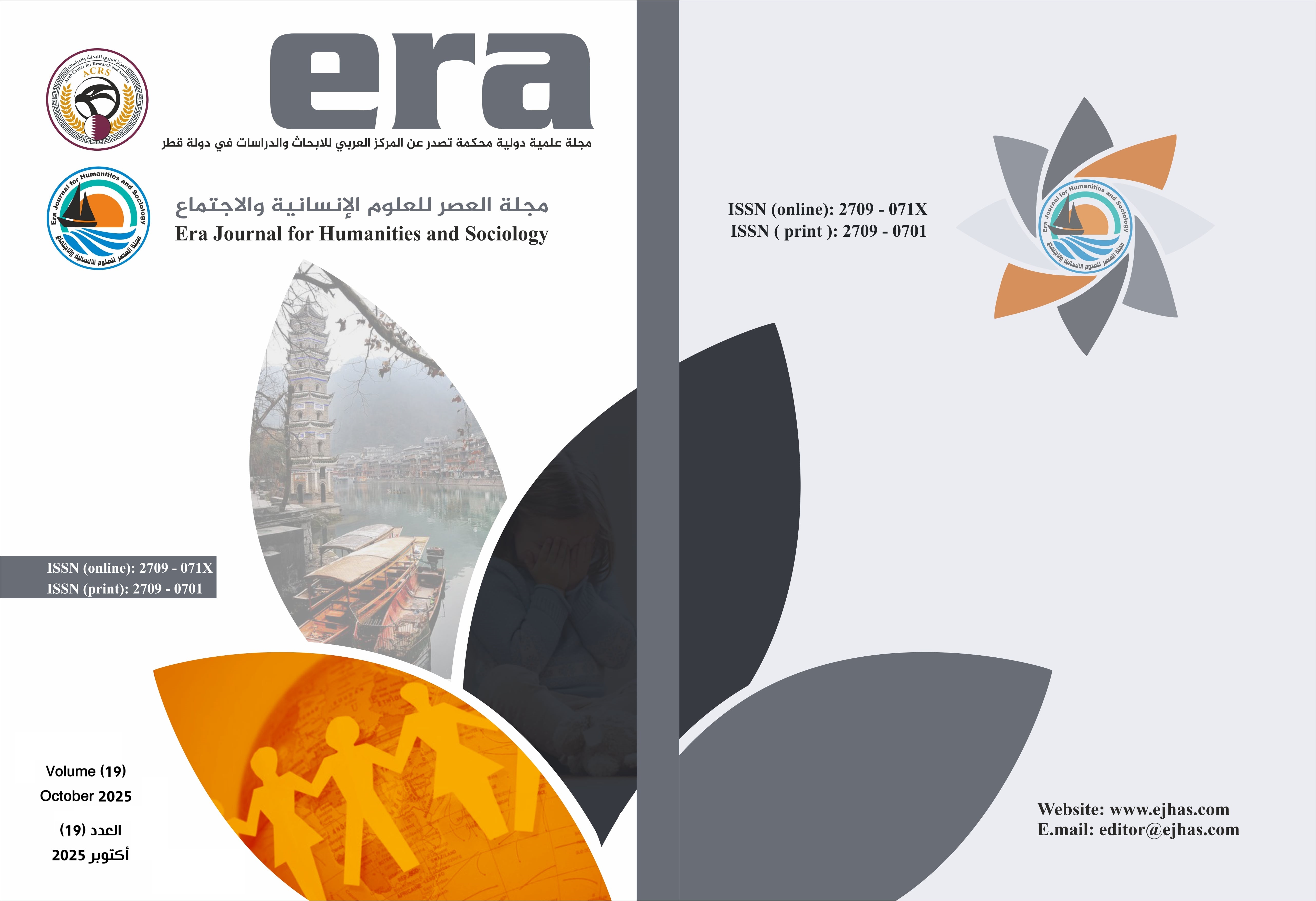Estimation of Flow Volume in Wadi Harran Basin in Eastern Iraq Using the SCS-CN Method
Abstract
Surface runoff is considered one of the most significant water resources in arid and semi-arid environments. Estimating the volume of surface runoff through the application of Geographic Information Systems (GIS), along with maps detailing the geomorphological and geological characteristics of the Wadi Haran basin, is an essential process. This estimation is supported by mathematical equations based on the Soil Conservation Service Curve Number method (SCS-CN), which is among the most widely used approaches for calculating runoff volume.
The study area, Wadi Haran basin, covers approximately 1,895 km². The Curve Number (CN) was found to be 92, with runoff volume (QV) values ranging between 582.71 m³ and 12.85 m³. The total surface runoff was calculated to be 198.2 m³. These results confirm the presence of significant surface runoff in the northern and northeastern parts of the basin. This is primarily attributed to the wide basin area and the presence of hard, low-permeability geomorphological soil characteristics that contribute to water accumulation and surface flow, rather than infiltration into the soil. Conversely, the southwestern part of the basin, characterised by higher-permeability geomorphological features, exhibits lower surface runoff.
Overall, the basin is characterised by increased surface runoff rates, particularly in the northern and northeastern sections, due to the broader basin area and low soil permeability compared to the southern and southwestern areas.
References
2. Hala Mohammed Saeed, & Lina Ali Abdullah. (2021). Morphometric characteristics of Wadi Haran and Eastern Tersaq Basin, Diyala Governorate. Diyala Journal, Diyala University, College of Education for Humanities, (87).
3. Jawad Kazem Al-Hasnawi, & Zaman Sahib Jawad. (2018). Spatial analysis of natural features in Al-Mahawil District. University of Babylon Journal of Humanities, 26(8).
4. Ishaq Saleh Al-Akkam, & Nawal Kamel Alwan. (2015). Estimation of surface runoff volume in Wadi Dweirij Basin using remote sensing and GIS techniques. Journal of Geographical Research, (21), University of Baghdad, College of Education for Women.
5. Islam Saber Amin Desouki. (2019). Application of RAP/RAC model to estimate potential water erosion in the basins of Al-Mahqen and Muhallab, Marsa Matrouh Area – Egypt, using remote sensing and GIS. Faculty of Arts Journal, (51).
6. Eyad Abdul Ali Salman Al-Shammari, & Ali Majid Yaseen Al-Bu Ali. (2024). Evaluation of soil classification in Iraq’s exploratory maps: A case study of Western Al-Salibat area in Southern Iraqi plateau using modern technologies. Madad Al-Adab Journal, University of Wasit, College of Basic Education, 1.
7. Iman Mohammed Hasan, & Suhaib Hasan Khudair. (2022). Hydrological analysis of natural environmental characteristics of Erbil Basin. Proceedings of the 4th International Teachers’ Conference / Historical and Geographical Studies, University of Mosul, College of Education for Humanities.
8. Balqis Mabhut Nasser Salah, & Mohammed Ahmed Hamoud Miyas. (2023). Estimation of surface runoff volume using the SCS-CN model in Wadi Zabid Basin – Yemen. Sana’a University Journal for Humanities, 4(1).
9. Haadir Dhahir Mohammed Al-Qaisi. (2019). River meanders of the Tigris River in Al-Alam Subdistrict. Journal of Historical and Cultural Studies, 11(40).
10. Salem Qasim Al-Naqeeb, & Thabit Dawood Mahdar Yishi. (2003). Geological and hydrological study of the area between Jabal Atshan and Wadi Qasab south of Mosul.
11. Saadiya Mahdi Saleh Abbas. (2020). Study of some soil characteristics affected by salinity and their degradation in Basra Governorate using geospatial technologies. PhD Thesis, University of Basra, College of Agriculture.
12. Talal Maryoush Jari, & Nadia Hatem Ta’mah. (2018). Flood risks in Eastern Maysan Governorate valleys. Journal of the College of Education, University of Wasit, (33).
13. Abbas Fadel Al-Saadi. (2009). Geography of Iraq: Its natural framework, economic activity, and human aspect. Ministry of Higher Education and Scientific Research, University of Baghdad.
14. Ezzedine Saleh Al-Jawadi, Salem Qasim Al-Naqeeb, & Dhanoon Abdulrahman Dhanoon. (2021). Assessment of the suitability of Al-Fathah and Injana Formations clays for brick and ceramic industry in Nineveh Governorate. Iraqi National Journal of Earth Sciences, 21(1).
15. Faisal Abdul Fattah Nafi’. (2019). Desertification and its impact on marshlands in Southern Iraq. Al-Mustansiriya Journal for Arab and International Studies, 16(68).
16. Qasim Juma Saleh. (2022). Sand and gravel quarries on the lower banks of the Great Zab River and their effect on land surface changes between Aski Kalk and Al-Mukhallat. Journal of Education for Humanities, 2(6).
17. Mustafa Helou Ali, & Tarek Juma Ali Al-Mawla. (2018). Land cover classification and land use in Maysan Governorate using remote sensing data and hybrid classification methods. Journal of Arts, University of Baghdad, 1(125 Suppl.).
18. Hala Mohammed Saeed, & Lina Ali Abdullah. (2021). Morphometric characteristics of Wadi Haran and Eastern Tersaq Basin, Diyala Governorate. Diyala Journal, Diyala University, College of Education for Humanities, (87). [Duplicate – consider removing]
19. Hala Mohammed Abdulrahman. (2016). Geomorphological evolution of Badra Fan. Journal of the College of Education for Women, University of Baghdad, 27(1).
20. Govindaraju, T. Y., Vinutha, C. J., Rakesh, S., Lokanath, S., & Kishor Kumar, A. (2024). Surface runoff estimation using the SCS-CN method for Kurumballi sub-watershed in Shivamogga District, Karnataka, India.
21. Youssef Sami Haj Bazal. (2022). Geomorphological risks of slopes in Erbil. AL-meed Journal, 11(42).
22. Abdul Ghani Soomro, Muhammad Munir Babar, Anila Hameem Memon, Arjumand Zehra Zaidi, Arshad Ashraf, & Jewell Lund. (2019). Sensitivity of direct runoff to curve number using the SCS-CN method. Journal Name Not Provided, 5(12), December.
Copyright (c) 2025 Shatha Abbas Jassim

This work is licensed under a Creative Commons Attribution-NonCommercial-NoDerivatives 4.0 International License.



